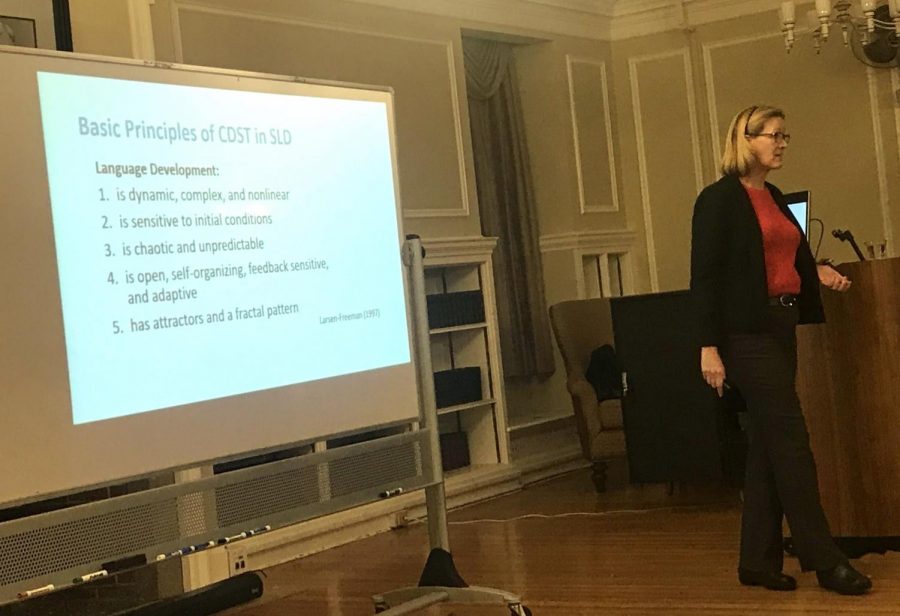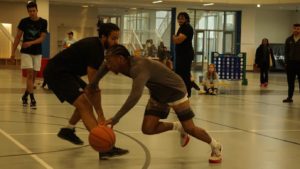Wesleyan Professor Presents Linguistics Research
Dr. Elizabeth Hepford spoke last Tuesday night about her second language acquisition research.
December 6, 2018
Dr. Elizabeth Hepford, an assistant English Second Language professor at Wesleyan University, brought her research to Central Connecticut on behalf of the English Department.
Hepford focused on the complex dynamic systems theory, a non-traditional second language acquisition approach.
“When you’re doing a study with complex dynamic systems theory, you don’t go in with a hypothesis. You take the data, you look at it and you decide what you’re seeing,” Hepford said when introducing the theory.
The event was held last Tuesday in the Marcus White Living Room.
Hepford served as a Peace Corps volunteer in Russia in 2001 before earning her master’s degree in teaching English as a second language at Arizona State University in 2005. She then earned an applied linguistics doctorate degree from Temple University in 2017 with her dissertation titled, “The dynamic learning trajectories of complexity, accuracy and fluency: A longitudinal case study,” for which she presented her findings during the event.
For decades, the information processing model (IP), a linear path of development theory, has been widely accepted amongst linguists for both the acquisition of first and second languages. Hepford challenged IP with a view that doesn’t rely on linguistic principles, but instead presumes language creativity stems from repetitive usage by the learner with others, in essence arguing that acquisition isn’t linear.
Hepford chose to examine a single participant she named Juan, who was a 33-year-old native spanish speaker earning his master’s degree, for 15 months. The two would meet bi-weekly where they would converse, and she would later analyze his English language performance.
“What I was analyzing for was how his language advanced while he was immersed. I wasn’t doing teaching techniques. I wasn’t looking at anything specific. I just wanted him to talk,” Hepford said.
Hepford used four types of stimuli to voice record and study, including narrative conversations, storytelling using a picture book featuring a boy and his pet frog, action descriptions using Mr. Bean videos without sound and picture descriptions. In her analysis, she listened to the recording to find 200-word passages as a sample of Juan’s complexity, accuracy and fluency.
Once her findings were presented, the floor was opened to questions. Dr. Matthew Ciscel, a professor and Applied Linguistics Coordinator at CCSU, called attention to the concept of cognitive strain, a variable Hepford had accounted for in her research, to explain diminishing differentials, calling Hepford’s assignment of cognitive strain a “logical leap” in areas where he thought her evidence could not be fully supported.
Ciscel requested she further explain her reasoning behind labeling the results in Juan’s speech production as cognitive strain instead of another variable.
“What really gave me the confidence to say what was happening was going back and actually looking at the speech samples, and seeing that, ‘Oh, here this changed,’” Hepford said.
After answering more questions relating specifically to her analysis and findings, Dr. Gilbert Gigliotti, a CCSU English professor, asked whether Hepford told participants they hadn’t improved, referring to previous slides where Hepford presented a study done on six participants by linguist Diane Larsen-Freeman. At the end of Larsen-Freeman’s study, some areas of the participants’ speech had improved, diminished or stayed the same.
Hepford referenced another one of her participants who she became very close with, and at the end of the study, discussed her findings with him.
“In the end, we talked about everything, and he actually confirmed almost everything I said. He agreed. He knew his motivation changed, but he was excited to hear some things had improved as well,” Hepford said.






